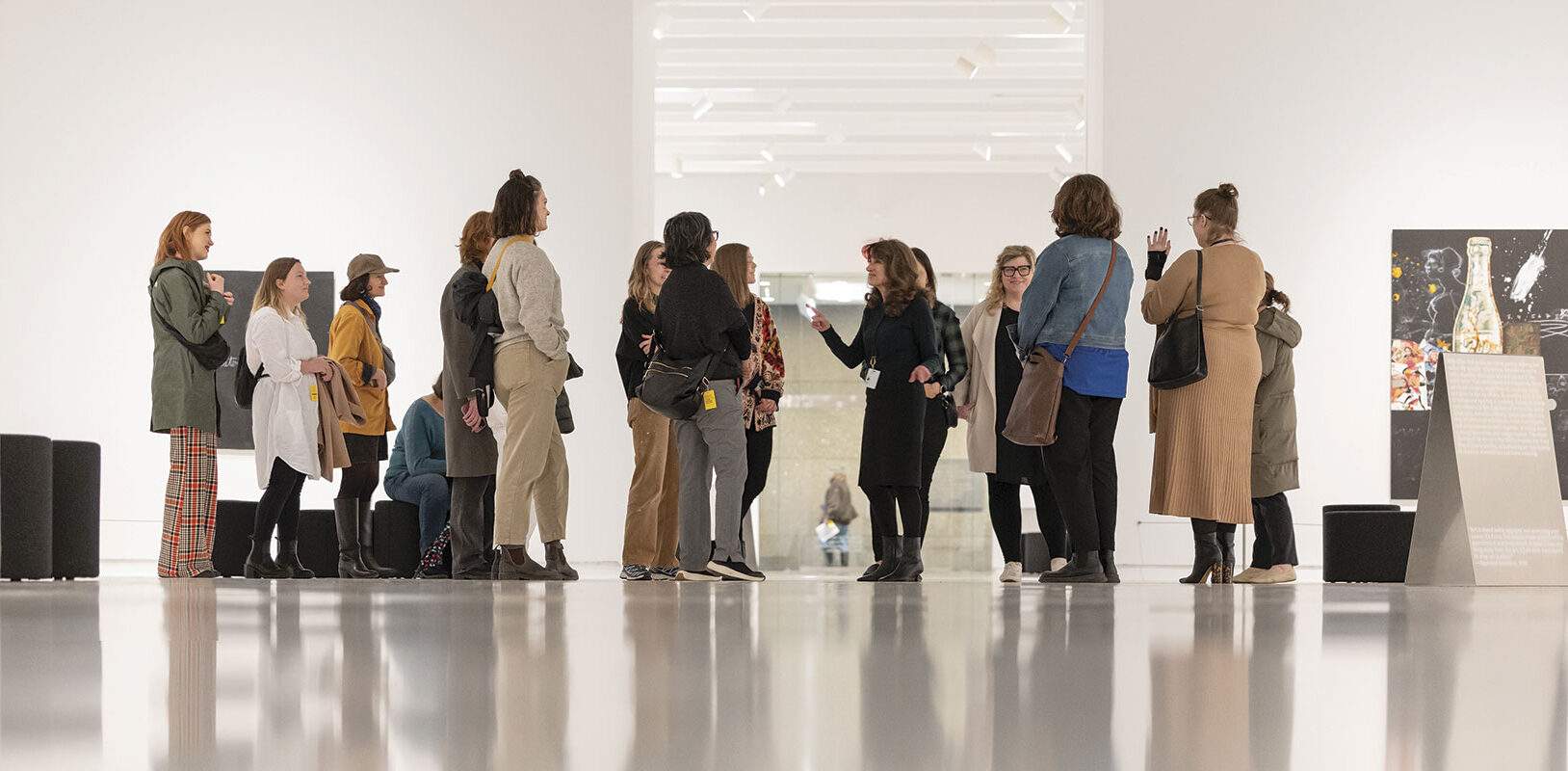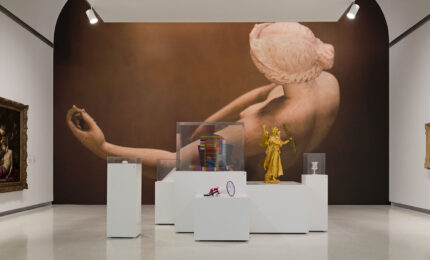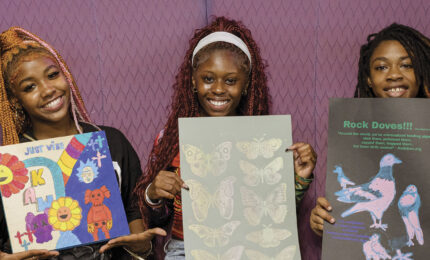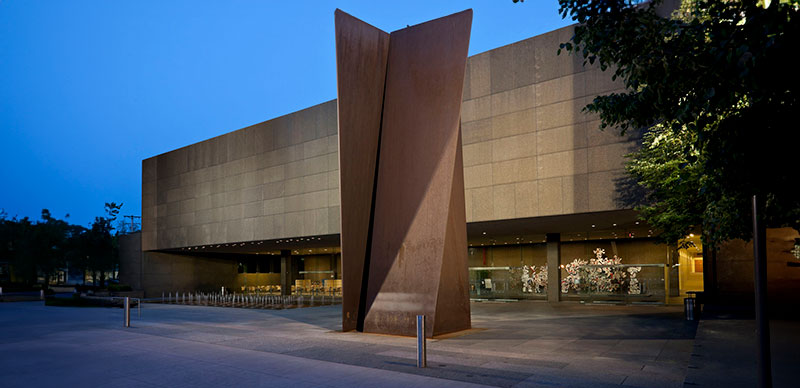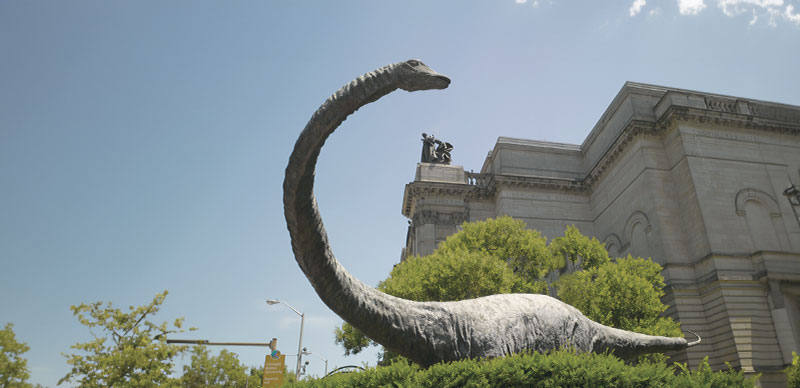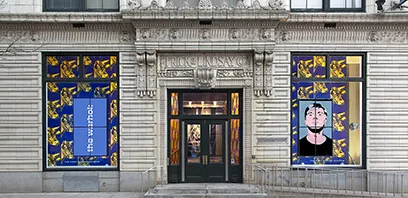On a spring afternoon, David King joined a small public group tour at Carnegie Museum of Art that he says felt like it was curated just for him.
King, 39, saw his favorite painting, Adolphe-William Bouguereau’s Hay-Maker, and compared its almost photographic realism with the muted, dreamy brushstrokes of another favorite, Renoir’s Young Girl in Pink. The group toured 11 works of art, discussing what inspired the artist at each stop.
King, a truck driver from Brookline, has used his museum membership to take scores of docent-led tours through the museum’s galleries since just before the COVID-19 pandemic—probably 100, he estimates. He knows there’s always something new to discover as he logs more miles in the galleries and the docents help him find it.
“They make me a better art viewer,” says King. “They bring me to stuff I may not look at on my own and expand my palate as an art viewer.”
Docent Lyn Silverman ends each of her tours by asking what piece of art the visitors will still be thinking about three weeks later. For King, it was Daniel Buren’s One Piece in Four Parts, featuring four striped panels of cloth stapled to the corners of an otherwise stark wall. Buren’s stripes help viewers appreciate a structural element they otherwise might walk straight past. King and Silverman joked that they’ll take greater notice of stripes in the broader world, never looking at a crosswalk the same way again.
More than 300 docents like Silverman have devoted nearly a million volunteer hours to connect no less than a million people with art since the Museum of Art’s Edward Larabee Barnes building opened in 1974, according to Lucy Stewart, senior manager of lifelong learning for Carnegie Museum of Art.
It was then that the museums’ Women’s Committee organized an all-volunteer force to provide guide services in the expanded Museum of Art.
“The docent program is deeply embedded in the volunteer structure of Carnegie Museums,” Stewart says. “They provide so many ways for adults and kids to connect with art, and the program continues to grow and flourish at a time when other museums have done away with docent programs.”
Going strong after celebrating its 50th anniversary last year, the docent program stays relevant because docents are always learning, Stewart notes.
From absorbing new exhibitions and works added to the collection to adapting to the ongoing reinstallation of galleries, docent education is constantly evolving to meet visitors’ wide range of interests and needs.
Current chair of the docent program Scott Grosh says one of his more memorable tours occurred several years ago during a Thursday evening public program.
Lots of people were mingling in the museum lobby when Grosh was about to begin a tour, and then something unexpected happened.
“I ended up walking up the Grand Staircase and realized about 70 people were following me,” Grosh recounts. “Those [evening] events are geared toward young adults and people were there to have fun, so those tours are really interesting.”
Even at top volume, Grosh was challenged to engage such a large crowd, so he had to tackle the tour with a flexible, creative approach. As he ascended the staircase commenting on the John White Alexander murals, tour goers repeated his comments backwards, passing the information down their ranks in a telephone game-style.
The docent program was the ideal retirement activity for Grosh when he finished a career as an art teacher and administrator in Pittsburgh Public Schools.
“I was looking around for something to do, and I wanted it to be something that would connect with art, but also be of some service to the community,” says Grosh, of Mt. Lebanon.
No Art Pedigree Needed
Grosh’s experience as an art teacher certainly is a benefit when he tackles docent duties, but an art background isn’t required. The docent team includes attorneys, accountants, nurses—people from all walks of life; some working, some retired.
 Photo: Joshua Franzos
Photo: Joshua FranzosAnne George, a retired computer science professional from the North Side, celebrated her first anniversary as a docent in April.
George’s participation in Mindful Museum, a weekly program bringing yoga, drawing classes, and various other activities for the over-55 crowd to the Museum of Art, sparked her interest in volunteering.
She’d never done anything quite like the docent program. But, overcoming some initial hesitation, George flung herself into the yearlong docent training, starting with an art history “Crash Course” reviewing artistic styles from ancient Greece through today.
“I turned up white-knuckled at Crash Course—armed with a pen and a notebook and scared to death,” George recalls. “It was for nothing. I thought I had to know everything and teach everything, but you interact with visitors to create conversations, and then start to infuse some of the facts and figures you know as it works in with the group dynamic.”
Docent and group tour coordinator Kathy Kienholz developed Crash Course, an intensive college-style seminar required as part of docent learning. The seminars are now available online, and Kienholz supplements them with a weekly one-hour course. Expanding when courses are available ensures that docent learning is more accessible to students and individuals who work full time.
Stewart and Kienholz also hope to grow the docent program’s volunteer base by offering the course more frequently. Prior to 2023, the docent training course was offered about every four years.
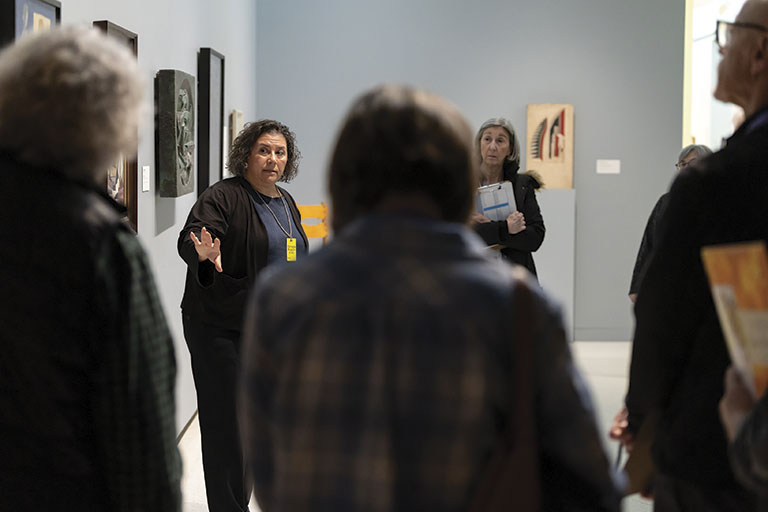 Photo: Joshua Franzos
Photo: Joshua Franzos“One thing I captured from our training is taking a 20- to 30-minute look. Just sit in front of a work and see what you see in there.”
Anne George, Carnegie Museum of Art docent
“It was like the Olympics,” Kienholz quips. “The idea now is, if we offer it every year, we’ll have smaller, more intimate classes, and a more regular influx of volunteers.”
After a COVID-related lull in recruitment, participation in the docent program nearly doubled last year, growing from around 30 docents to 60. This year’s class has about 20 more docents-in-training.
A Rich Learning Community
In addition to Crash Course, docent trainees study art engagement methodology to learn how to draw visitors into meaningful conversations through close looking, open-ended questions, and active listening techniques.
The trainees hone these techniques on 10-minute, then 20-minute tours before completing their training with a full-hour “activation” tour. Along the way, experienced docents share their knowledge and mentor the new group of docents.
Retired business management professional and university instructor Diane Ramos served as a mentor to the last two docent training classes and says the interaction among the team is as satisfying as helping visitors experience art in new ways. She’s developed cherished friendships through the docent program and recently visited two members of her training class who moved away and are now docents at other museums.
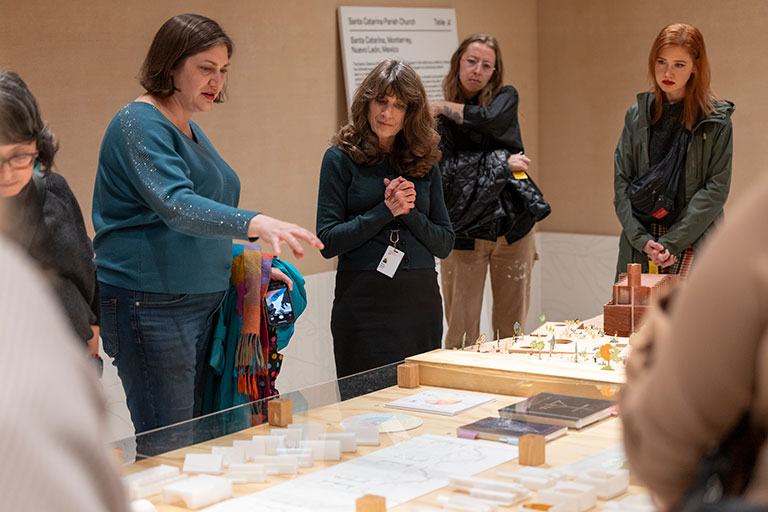 Photo: Joshua Franzos
Photo: Joshua Franzos“We develop this bond as part of a really rich learning community centered around art,” Ramos says. “We come for the art, and we stay for the people.”
Once docents become active, they attend weekly professional learning sessions from September through June to stay up to date on the changes to the collection and glean information from curators that will help them lead conversations with visitors.
There’s no script to follow, however. Each docent develops tours based on what they relate to. A new lunchtime tour, called “3 in 30,” gives docents a chance to be especially creative, selecting three works of art to feature for guests in 30 minutes, and tying them together with a common idea.
“They make it their own, which is one of the attractions of it,” Kienholz says.
Preparation and ongoing research are part of the docent experience. George regularly takes advantage of the docent library, perusing dossiers the museum has amassed on the artists in the collection, along with reference materials on various artistic movements and time periods. She also does a “quiet walk-through” when a new featured exhibition comes in, observing and reflecting on the installation.
“One thing I captured from our training is taking a 20- to 30-minute look,” she says. “Just sit in front of a work and see what you see in there.”
Something for Everybody
Ramos, of Fayette County, discovered art as a first-year student at the University of Pittsburgh in the late 1960s, when her student ID got her free museum admission. She says she has a special fondness for leading student tours.
On one of her earliest school tours, she was ecstatic to see a group of initially disinterested teenage boys from a rural area become mesmerized when they recognized something from home: van Gogh’s Wheat Fields After the Rain looked just like the fields in their own community.
 Photo: Joshua Franzos
Photo: Joshua Franzos“We develop this bond as part of a really rich learning community centered around art. We come for the art, and we stay for the people.”
Diane Ramos, Carnegie Museum of Art docent
“It was a good reminder that there’s something here for everybody,” she says. “If you make it exciting, they will see the museum as part of their life and a place for respite, inspiration, and just plain enjoyment. It’s a joy to be a person making that happen for somebody, especially a kid.”
Whether hosting a school group, a family, or a few strangers gathered for a public tour, docents work to acknowledge everyone in the group and give each of them space to participate, Stewart says. While docents guide, everyone is encouraged to discover and reach their own conclusions about art.
“Visitors aren’t static, and museums can’t be static either,” Stewart notes. “We’re ever shifting and constantly learning.”
Docents also play an instrumental role in welcoming everyone and accommodating visitors with special needs.
Some of Ramos’ most rewarding experiences have stemmed from the museum’s programs to help visually impaired guests enjoy a museum experience. She received special training to give visual description tours, depicting various pieces of art and inviting both visually impaired and sighted visitors to join in conversation about the works.
One visually impaired high school student was so appreciative of the special tour Ramos gave her advanced creative writing class that she wrote and recorded an original song in Ramos’ honor.
“Whenever I’m feeling a little inadequate,” Ramos says, “I play Diane the Docent and remember I touched the heart of this extraordinary young woman.”
